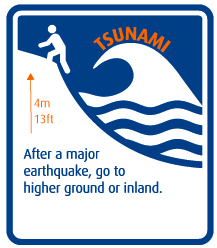- Do not go near the shore to watch a tsunami hit. If you can see it, you are too close to escape.

- Should a tsunami occur and you cannot get to higher ground, stay inside where you are protected from the water. It’s best to be on the landward side of the house, away from windows.
- Often tsunamis occur in multiple waves that can occur minutes apart, but also as much as one hour apart.
- Monitor the tsunami’s progress and listen for warnings or instructions from local officials. If you are safe when the first tsunami hits, stay put until authorities declare all is safe.
- After a tsunami hits, you may encounter flood waters. Flood waters can be dangerous to walk or drive through. Before driving anywhere, it is best to listen carefully to rescue officials who will be coordinating evacuation plans.
- Be aware of risks such as hypothermia from cold water or drowning from running water.
- follow the instructions of all emergency officials for your safety and the safety of those around you.
- In the first 24 hours, use the telephone only to report life threatening emergencies.
A tsunami is a natural hazard consisting of a series of unusually large waves formed by a large-scale disturbance of water bodies. One of the primary causes of tsunamis is an earthquake, but tsunamis may also be triggered by landslides, volcanoes or explosions.
If you are near the ocean and feel a major earthquake lasting 60 seconds or more, or if the motion makes it hard to stand, get to higher ground immediately – do NOT wait for an official warning. THE SHAKING IS YOUR WARNING.
Local government officials may not have enough time to issue a warning to residents in the event of tsunami created by a near-shore earthquake. Roads may be congested and communications systems compromised.
Generally, 4 metres or 13 feet elevation above sea level is considered a safe distance from the ocean. You DO NOT need to go to the highest point in the Region.
In the Event of an Immediate Tsunami Threat:
All areas of the coastline will not be impacted equally. Within very short distances, the effects of a tsunami may vary considerably and there could be dramatic differences in wave height and impact.
The Province has established three levels of Tsunami issued alerts along the BC Coastline. This alerting system may change as time passes and more information is gathered on the earthquake/tsumani. Once and alert is issued, stay tuned for upgrades or downgrades.
Tsunami Warning
This is issued when a potential tsunami with significant widespread inundation is imminent or expected. Warnings:
-
alert the public that widespread, dangerous coastal flooding and powerful currents is possible and may continue for several hours
-
alert emergency management officials to take actions like the evacuation of low-lying coastal areas, and the repositioning of ships to deep waters when there is time to safely do so
-
may be updated, adjusted geographically, downgraded, or canceled
-
are initially normally based only on seismic information to provide the earliest possible alert
Tsunami Watch
This is issued to alert emergency management officials and the public of an event which may later impact the watch area. Watches:
-
may be upgraded to a warning or canceled based on updated information and analysis.
-
indicatate emergency management officials and the public should prepare to take action.
-
are normally issued based on seismic information without confirmation that a destructive tsunami is underway.
Tsunami Advisory
This is issued due to the threat of a potential tsunami which may produce strong currents or waves dangerous to those in or near the water. Coastal regions historically prone to damage due to strong currents induced by tsunamis are at the greatest risk. Advisories:
- may continue for several hours after the arrival of the initial wave, but significant widespread inundation is not expected for areas under an advisory
- may result in local officials closing beaches, evacuating harbors and marinas, and the repositioning of ships to deep waters when there is time to safely do so
- are normally updated to continue the advisory, expand/contract advisory areas, upgrade to a warning, or cancel the advisory
